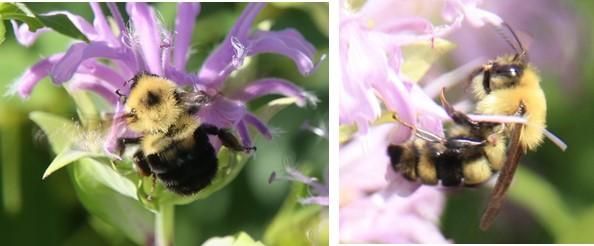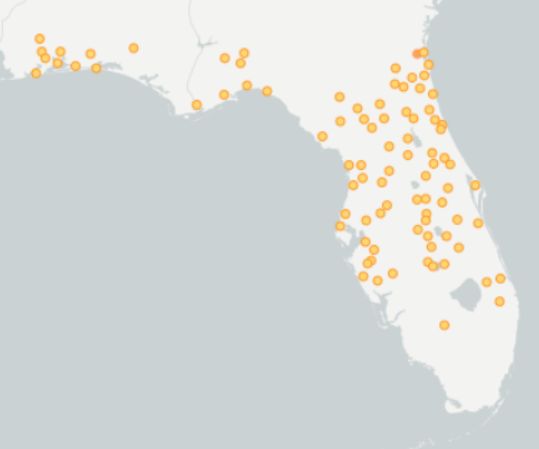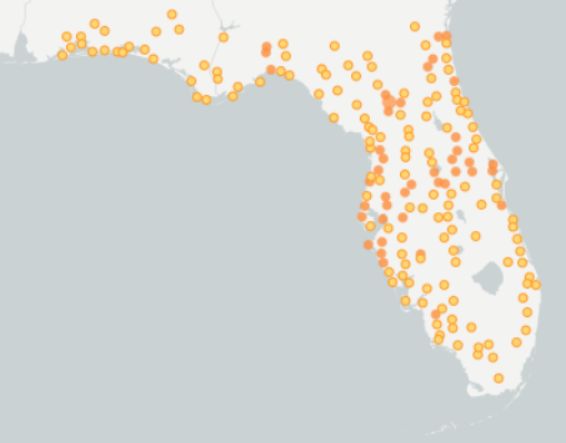The Featured Creatures collection provides in-depth profiles of insects, nematodes, arachnids and other organisms relevant to Florida. These profiles are intended for the use of interested laypersons with some knowledge of biology as well as academic audiences.
Introduction
This publication is a general guide to field identification, species description, and biology of the five bumble bee species (Bombus spp.) found in Florida. This guide to bumble bee identification in Florida would also be usable for coastal South Carolina, Georgia, Alabama, Louisiana, Mississippi, and Arkansas. However, it is not comprehensive for the northern/mountainous parts of those states where Bombus auricomus, Bombus citrinus, Bombus fervidus, Bombus flavidus, Bombus perplexus, Bombus sandersoni, Bombus terricola, and Bombus vagans can occur.
Distribution
All five bumble bee species found in Florida range as far north in the United States as the Great Lakes region, where other bumble bee species can also be found (Laverty and Harder 1988). In North America, bumble bee diversity is highest in more northern, temperate, and montane (higher elevation) areas and declines from north to south (Williams et al. 2014). In Florida specifically, there are only five species, all of which can be found in the northern part of the state. Species diversity declines moving south in Florida.

Credit: Joel Neylon
Biology and Life Cycle
The life cycle of a bumble bee colony in Florida generally begins in late winter or early spring (late January through March) when new queens search out a nest site for the year. A nest is typically something that has been lived in by another animal previously. Common nest locations include underground cavities such as old mouse nests or rodent burrows, aboveground cavities such as bird houses or crevices by the foundations of buildings, or on the surface of the ground in dense grass (Mitchell 1962; Morse 1982). All five species in Florida typically nest at or below ground, but each species has unique preferences for nest sites. Bombus pensylvanicus tends to nest at the surface of the ground or slightly below ground while Bombus fraternus and Bombus impatiens almost always nest underground (sometimes deep) (Medlar and Carney 1963; Williams et al. 2014). Bombus bimaculatus usually nests underground but has been recorded aboveground in buildings, and Bombus griseocollis will nest on the surface, underground, or aboveground, and is frequently recorded nesting in buildings or bird houses (Medlar and Carney 1963; Williams et al. 2014).
After she selects a nest site, the queen will secrete wax from her abdomen and make the cells for the first workers, who are also females. Her time is then divided between incubating the young and foraging for flowers from which she gathers pollen and nectar while she waits for her first workers to hatch. Once her workers have emerged, the queen will stay in the nest while the workers do all the work outside of the nest including foraging. The queen will continue to lay worker eggs until later in the season (late summer/fall), when she switches first to laying male eggs, and finally to laying eggs that will hatch new queens. The new queens spend their early days eating nectar and pollen to fatten for hibernation, then mate with a male, and finally leave the hive to search for a suitable location to hibernate for the winter (generally in loose soil like compost, mole hills, or well-drained slopes). Newly mated queens will be the only members of a bumble bee colony to survive winter. The old queen and all the males and workers die by late fall/early winter (Mitchell 1962; Morse 1982). Bumble bees in Florida still generally follow this yearly cycle, though the Florida “winter” is very short, and bumble bees can be seen foraging nearly year-round, with males particularly active in late fall/early winter and new queens active in late winter/early spring.

Credit: Joel Neylon
Identifying Bumble Bees
Bumble bees in Florida can generally be distinguished and identified to species level with clear photographs from the field. If you spot one, take a moment to snap a few photos at different angles and upload them to www.inaturalist.org, where they will be identified and included in extensive range maps, useful to researchers studying bumble bees.
Try to get shots that include a clear view of the abdomen and the top of the thorax. Because of the positioning of bumble bee wings, shooting from a side angle usually provides the clearest view of the bee’s abdomen. All Florida Bombus species may be identified with a single photo; however, it is advisable when you are first starting to take several photos until you have a sense of the important marks that will allow identification of species.
A note on size: Bombus size is quite variable depending on caste and time of year. Queens are the largest bees; early season workers (spring workers) tend to be smaller than queens and late season workers (summer and fall workers). Because of the variability, size is generally not a good field mark to rely on for Bombus ID.

Credit: Joel Neylon
Description of Florida Bumble Bee Species
T = tergite (1–7), F = flagellomere (1–11). See Figure 3 for reference to body parts.
Subgenus Pyrobombus
Bombus (Pyrobombus) bimaculatus (two-spotted bumble bee)
Distribution
Found throughout the northern two-thirds of the state, though not as common as other species.
Female
Yellow vertex, long uneven hair, dark wings, distinct black spot on the scutum. T1 yellow followed by two variable sized patches of yellow hair on T2 typically confined to the middle of the segment. T3-6 black. Can be mistaken for Bombus impatiens queens or for Bombus griseocollis workers/queens. Size: queen 18–22 mm (~3/4–1 in); worker 10–16 mm (~3/8–5/8 in) (Schuh et al. 2010).
Male
Yellow face and vertex, long hair, smoky wings. Typically shows distinct black spot on scutum, but this can be reduced or absent. T1 yellow; T2 yellow with black hairs in the lower corners (these dark spots on T2 are the “two spots” referenced in the name); T3 typically black, sometimes with yellow laterally but very rarely completely yellow; T4 often yellow; T5 sometimes yellow; T6/7 rarely yellow. Reasonably distinct. Size: 12–15 mm (~1/2–5/8 in) (Schuh et al. 2010).

Credit: Joel Neylon

Credit: © OpenStreetMap contributors with data available under the Open Database License. DOI10.15468/dl.jxmq5k
Bombus (Pyrobombus) impatiens (common eastern bumble bee)
Distribution
One of the two most common bumble bee species in Florida, the other being Bombus pensylvanicus. Primarily seen in the northern two-thirds of the state, but it has been found in the southern portion as well.
Females
Yellow vertex, short hair, scutum yellow with black hairs intermixed throughout in workers and a narrow black slit in the middle for queens. Queens have darker wings while workers have clear wings. T1 yellow, T2–6 black. Reasonably distinct, but queens may be mistaken for Bombus bimaculatus. Size: queens 21–23 mm (~1–1¼ in); workers 9–14 mm (~3/8–5/8 in) (Schuh et al. 2010).
Males
The same as female workers, but with yellow on the face. Size: 12–14 mm (~1/2–5/8 in) (Schuh et al. 2010).
Rare Variants
Queens, workers, and males occasionally can show yellow, red, or white on T2–6 due to damage at the larval stage. Damage like this can show in other Bombus species, but it is most commonly reported in Bombus impatiens.

Credit: Joel Neylon

Credit: © OpenStreetMap contributors with data available under the Open Database License. https://doi.org/10.15468/dl.jxmq5k
Subgenus Cullumanobombus
Bombus (Cullumanobombus) fraternus (southern plains bumble bee)
Distribution
Generally uncommon in Florida. Most recent records are from the Panhandle of the state, though there are records from the northern half of the Peninsula as well.
Female
Black vertex, short hair, short malar space. Scutum yellow with black band connecting the tegula. Scutellum completely yellow; completely yellow on T1 and T2. Somewhat distinct but could be mistaken for Bombus pensylvanicus. (Note that Bombus pensylvanicus will have yellow on T3 and would be unlikely to have a full yellow scutellum as seen on Bombus fraternus.) Size: queen 25–27 mm (~ 1–1 1/8 in); worker 15–19 mm (~5/8–3/4 in) (Schuh et al. 2010).
Male
Large, bulging eyes; yellow vertex; yellow thorax with a round black spot or black stripe. Completely yellow on T1 and T2. Long, extended abdomen. Reasonably distinct, but might be mistaken for B. griseocollis, which also has bulging eyes. Size: 22–25 mm (~7/8–1 in) (Schuh et al. 2010).

Credit: Male bee, Abby Darrah; female bee, Joel Neylon

Credit: © OpenStreetMap contributors with data available under the Open Database License. DOI10.15468/dl.95g4xa
Bombus (Cullumanobombus) griseocollis (brown-belted bumble bee)
Distribution
Throughout the northern two-thirds of the state, though not as common as Bombus impatiens or Bombus pensylvanicus.
Female
Black vertex; short, dense hair; small, distinct black spot on the scutum. Dark wings; yellow on T1; brown or yellow in a W- or U-shaped pattern on T2; black on T3–6. Could be mistaken for B. bimaculatus queens or workers. Size: queen 18–23 mm (~5/8–1 1/8 in); worker 10–16 mm (~3/8–5/8 in) (Schuh et al. 2010).
Male
Large, bulging eyes; yellow vertex; short, dense hair; large, round, black spot on scutum; T1 yellow; T2 with variable amount of brown or yellow. Could be confused with Bombus fraternus. Size: 12–18 mm (~1/2–5/8 in) (Schuh et al. 2010).

Credit: Joel Neylon

Credit: © OpenStreetMap contributors with data available under the Open Database License. https://doi.org/10.15468/dl.mwd75n
Subgenus Thoracobombus
Bombus (Thoracobombus) pensylvanicus (American bumble bee)
Distribution
Widespread and relatively common across the state, except the area around Lake Okeechobee. The most likely of the five species to reach the southern tip of the state.
Females
Black vertex, short hair, long malar space. Black across the scutum; scutellum black or with some yellow hairs intermixed. T1 with yellow along the back edge; T2 and T3 all yellow; black on T4–6. Size: queen 22–26 mm (~ 7/8–1 in); worker 13–19 mm (~1/2–5/8 in). Reasonably distinct, but an individual with extensive yellow on the scutellum might be mistaken for Bombus fraternus (Schuh et al. 2010).
Males
Vertex and face black with some yellow hairs intermixed. Antennae proportionally longer than other species. Black across scutum extending under the tegula on the side of the thorax; scutellum ranging from black to yellow, though usually with some yellow hairs intermixed. T1–5 yellow; T6 usually yellow but occasionally black; T7 usually yellow-orange but occasionally black. Size: 15–21 mm (~5/8–3/4 in). Reasonably distinct (Schuh et al. 2010).

Credit: Joel Neylon

Credit: © OpenStreetMap contributors with data available under the Open Database License. https://doi.org/10.15468/dl.bqttr8
Simple Keys to Florida Bumble Bees
This guide uses characteristics that can be seen with the naked eye in the field to differentiate Bombus species in Florida. It is thus different from a typical dichotomous key that often includes characteristics only visible using microscopy. This guide should be treated more as general information and descriptions and not concrete rules given that the wear on an individual bee can alter field marks. Also, inadequate lighting, suboptimal angels, and color variances can make identification challenging and lead to misinterpretations and misidentifications. Always make IDs using multiple field marks.
Female Key
T = tergite (1–7), F = flagellomere (1–11). See Figure 3 for reference to body parts.
1. Scutellum with black hairs mixed with yellow or completely black = Bombus pensylvancius. Note also yellow on T1–3.
1’. Scutellum completely yellow. Note also black hairs on T3 = 2
2. T2–6 completely black = Bombus impatiens. Note also short hair and black and yellow hairs intermixed across the scutum.
Remaining three species are less common in Florida
2’. T2 with yellow or brown hairs present but T3 black = 3
3. T2 completely yellow = Bombus fraternus. Note also the wide black stripe across the scutum.
3’. T2 with black in the lower corners = 4
4. Long, uneven hair with yellow vertex = Bombus bimaculatus. Note also the round black spot on the scutum.
4’. Very short, even hair with black vertex = Bombus griseocollis. Note also the narrow black spot on the scutum.
A Difficult Female Pair
Bombus impatiens vs. Bombus bimaculatus queens
- Black hairs in a distinct round spot in the middle of the scutum = Bombus bimaculatus. Note also long hair.
- Few if any black hairs intermixed throughout the yellow hairs of the scutum = Bombus impatiens. Note also short hair.

Credit: Joel Neylon
Males
Since males do not collect pollen, they lack a corbicula (pollen basket) on the hind leg, which makes male hind legs appear skinnier than female hind legs. Males also have one additional tergite (so 7 instead of 6 abdominal segments) and one additional flagellomere (11 flagellum segments on the antenna instead of 10), which makes both the body and antennae longer. Side note: while males do not collect pollen to provision their offspring, that does not mean that they do not pollinate flowers. When they visit flowers to get nectar, they can still get covered in pollen and transfer that pollen to other flowers.

Credit: Joel Neylon
Male Key
T = tergite (1–7), F = flagellomere (1–11). See Figure 3 for reference to body parts.
T2–7 completely black = Bombus impatiens. Note black and yellow hairs intermixed across scutum.
1’. Yellow present lower on the abdomen = 2
Uniform yellow on T1–5 at least = Bombus pensylvanicus. Note that yellow can extend the entire length of the abdomen, and there will often be orange on T7.
2’. Black on T3 = 3
Remaining three species are less common in Florida
3. Regular (non-bulging) eyes. Note also T2 partial to fully yellow; may also have yellow on T4/5, and sometimes on T3 laterally, but rarely fully yellow = Bombus bimaculatus.
3’. Large bulging eyes = 4
4. Complete yellow on T2, long extended abdomen = Bombus fraternus.
4’. Black in the lower corners of T2 = Bombus griseocollis.
Selected References
Laverty, T. N., L. D. Harder. 1988. “The Bumble Bees of Eastern Canada.” Canadian Entomologist 120:965–987. https://doi.org/10.4039/Ent120965-11
Medlar J. T., D. W. Carney. 1963. “Bumblebees of Wisconsin (Hymenoptera: Apidae).” Agricultural Experiment Station, University of Wisconsin, Madison.
Mitchell, T. B. 1962. “Bees of the Eastern United States. Volume II.” Technical Bulletin No. 152, North Carolina Agricultural Experiment Station.
Morse, D. H. 1982. “Behavior and Ecology of Bumble Bees,” pp. 245–322. In Social Insects, Vol. 3, edited by H. R. Hermann. Academic Press, New York & London. https://doi.org/10.1016/B978-0-12-342203-3.50009-6
Schuh, R. T., S. Hewson-Smith, and J. S. Ascher. 2010. “Specimen Databases: A Case Study in Entomology Using Web-Based Software.” American Entomologist 56:206–216. https://doi.org/10.1093/ae/56.4.206
Williams, P. H., R. Thorp, L. Richardson, and S. Colla. 2014. Bumble Bees of North America: An Identification Guide. Princeton Field Guide Series, Princeton University, Princeton, N.J.
For More Information
- Discover Life. Bombus griseocollis (DeGeer, 1773). Discover Life. (September 2023).
- Discover Life. Bombus bimaculatus Cresson, 1863. Discover Life. (September 2023).
- Discover Life. Bombus fraternus (Smith, 1854). Discover Life. (September 2023).
- Discover Life. Bombus pensylvanicus (DeGeer, 1773). Discover Life. (September 2023).
- Discover Life. Bombus impatiens Cresson, 1863. Discover Life. (September 2023).
- Pascarella, J. B., and H. G. Hall. The Bees of Florida. UF/IFAS Research Florida Agricultural Experiment Station. (September 2023).
- Weaver, J. R., S. M. Naranjo, E. Noordyke, and R. E. Mallinger. 2020. Bees of Florida. ENY-2046 Gainesville: University of Florida Institute of Food and Agricultural Sciences. https://edis.ifas.ufl.edu/publication/IN1285.